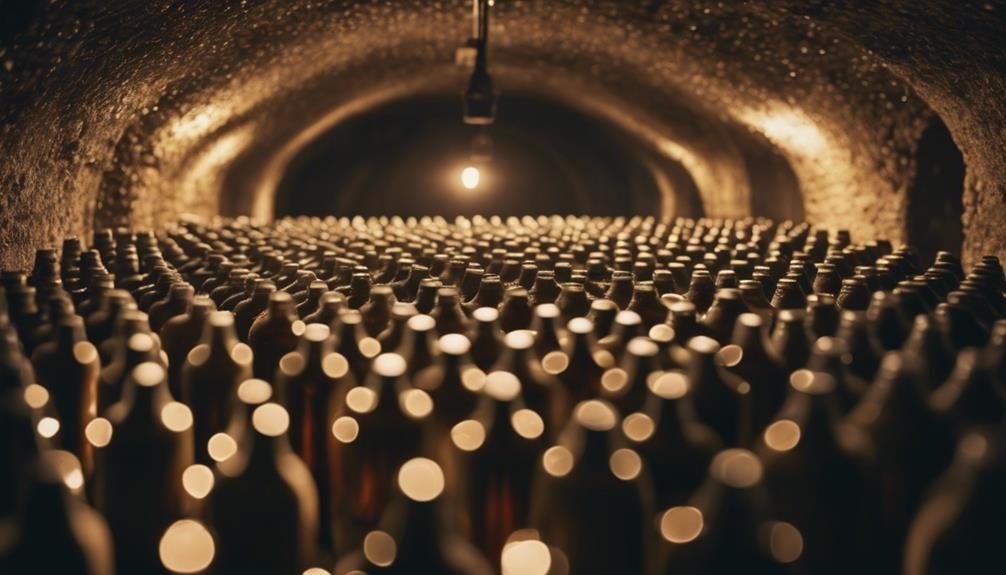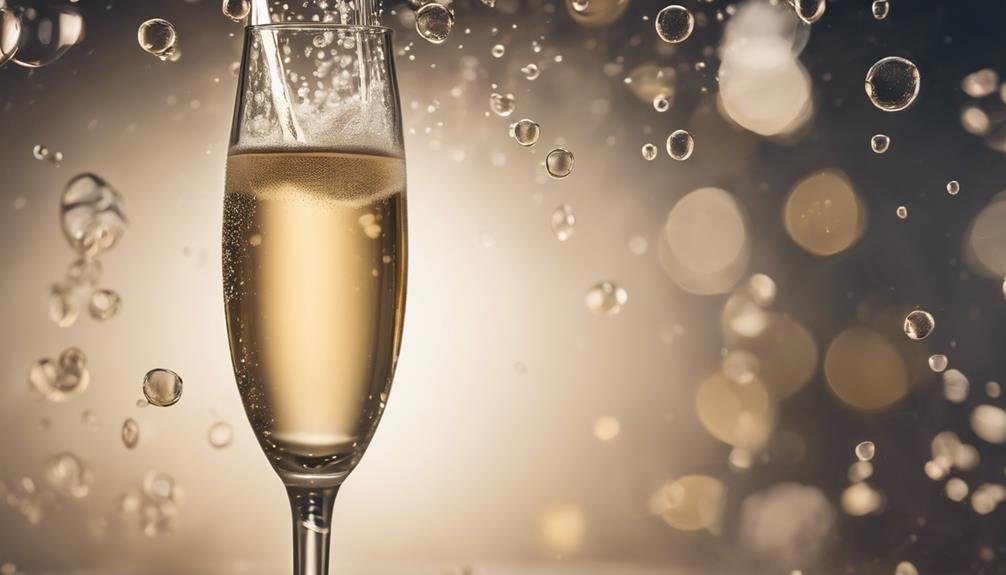Discover the magic behind Champagne bubbles through a blend of traditional and innovative production methods. Techniques like the Classic Method and Charmat Method influence effervescence and mouthfeel. Bubble size impacts texture, with smaller bubbles often indicating quality. Aging enriches flavor profiles, creating complexity through lees interaction. Riddling enhances integration and smoothness. This dynamic process showcases the artistry and skill behind each bottle, providing a sensory journey for enthusiasts. Explore further to reveal the intricate world of Champagne production, where every bubble tells a story of craftsmanship and tradition.
Champagne Production Methods
Champagne production methods encompass various techniques such as the Classic Method (Méthode Champenoise), Charmat Method (Metodo Italiano), and Tank Method, each contributing to the unique characteristics of this beloved sparkling wine.
The fermentation process in Champagne involves a second fermentation in the bottle for the Classic Method, contributing to its longer-lasting bubbles.
In contrast, the Charmat Method focuses on the fermentation process in pressurized tanks, resulting in bigger bubbles.
The Tank Method, also known as the Charmat-Martinotti Method, involves a secondary fermentation in large tanks, producing itty-bitty bubbles.
These carbonation techniques play an important role in shaping the effervescence and mouthfeel of Champagne, showcasing the diversity in production methods within the sparkling wine industry.
Champagne Bubble Characteristics
The characteristics of bubbles in Champagne play an essential role in defining the sensory experience of this renowned sparkling wine. When analyzing Champagne bubbles, two key aspects stand out:
- Bubble size, longevity: The size of bubbles can vary, affecting the texture and mouthfeel of the Champagne. Smaller bubbles are often associated with higher quality, while larger bubbles can provide a different sensation on the palate. The longevity of bubbles also impacts the overall effervescence of the wine, influencing how the aromas and flavors are perceived.
- Bubble formation, impact: The way bubbles form in Champagne can influence the release of aromatic compounds and contribute to the wine's overall bouquet. Additionally, the presence and persistence of bubbles can affect the Champagne's mouthfeel, enhancing the drinking experience.
Understanding Champagne Aging

A fundamental aspect in the domain of sparkling wine production involves delving into the intricate process of aging to comprehend the evolution of flavors and textures. The aging process of Champagne plays an essential role in developing its unique characteristics. As Champagne matures, it undergoes a transformation that enhances its flavor profile, creating a more complex and harmonious taste. The interaction between the wine and the lees during aging contributes to the development of rich and toasty notes, adding depth and nuance to the final product. Understanding the aging process is vital for appreciating the nuances of Champagne and the craftsmanship involved in its production.
| Aging Process | Flavor Development | Texture Enhancement |
|---|---|---|
| Lees contact | Rich and toasty notes | Creamier mouthfeel |
| Bottle aging | Enhanced complexity | Fine and persistent bubbles |
| Riddling process | Improved integration | Silky smooth finish |
Frequently Asked Questions
How Do I Choose the Right Glassware for Serving Champagne?
When choosing glassware for serving champagne, consider a flute for preserving bubbles and aromas due to its tall, narrow shape. Opt for a smaller size to maintain carbonation. The flute is preferred over the wider coupe for enhancing the champagne experience.
Are There Any Health Benefits Associated With Drinking Champagne?
While champagne is often associated with celebration, moderate consumption may offer some health benefits. Studies suggest that the polyphenols in champagne could have antioxidant properties, potentially supporting cardiovascular health. However, moderation is key for reaping any potential benefits.
Can Champagne Be Used in Cooking or Baking Recipes?
Champagne can elevate culinary creations with its effervescence and nuanced flavors. Incorporate it into sauces, marinades, and desserts like Champagne cocktails or Champagne-infused desserts for a sophisticated touch that adds depth and complexity to dishes.
What Are Some Common Myths About Champagne That Need Debunking?
Common myths about Champagne include it being only for celebrations, that all Champagne tastes the same, and that price equals quality. Champagne production myths and tasting misconceptions need debunking for a deeper appreciation.
How Can I Properly Store Leftover Champagne to Preserve Its Quality?
To properly store leftover Champagne for best preservation and quality, refrigerate the bottle tightly sealed with a Champagne stopper or cork. This method minimizes oxidation, extends Champagne longevity, and guarantees a fresh taste upon serving.
Conclusion
In the enchanting world of Champagne bubbles, the artistry and science behind their creation reveal a blend of tradition and innovation unlike any other. The intricate processes and techniques used in sparkling wine production result in a mesmerizing effervescence that captivates the senses.
Immerse yourself in the domain of Champagne bubbles, where each sip tells a story of craftsmanship and excellence that is truly unparalleled. Discover the magic of Champagne, where bubbles dance with unparalleled grace and elegance.
